Monday
Mandala ProjectsThe Sakyong’s Advisory Panel on Shambhala Environments
by Steve Vosper, Chair, Shambhala Environments
with Peter van der Molen, Associate Panel Member
Flashback
Back in the mid 1980’s: Amsterdam proudly owned a former bottle rinsing plant. Upstairs a forest of beams criss-crossing the attic; downstairs cold tiled floors, that were sloping and they were hard on the feet during walking meditation. A large pile of light green, yellow and pink fluffy flip-flops was brought in as a remedy. With a good dose of timely wrathful energy and a vast vision – the Amsterdam sangha was encouraged to renovate the building, transform the attic into a shrineroom and get rid of the flip-flops. One year later a frail but proud Vidyadhara Chogyam Trungpa Rinpoche blessed the building, making it the first owned property of then Vajradhatu in Europe.
About 18 years later, Amsterdam would get information and encouragement of a different kind: Eva Wong inspected the center and located the source of some energetic problems the sangha was coping with: burnout of the leadership, problematic practice environment, split energies within the building. This time a new round of renovations took place, resulting in a splendid center, radiating the royal teachings of the Shambhala lineage.
Sacred Space
In the fall of 2006 the Sakyong engaged in conversation with President Richard Reoch and others about establishing a group or committee to help explore and deepen our understanding of sacred space and review on his behalf any major building or facilities development projects throughout the Shambhala community. The purpose of the group was to encourage and facilitate communication between the Sakyong and the community, in order to establish a consistency and clarity of vision for the built environments of Shambhala.
The conversations touched on the importance of the principle of space or container in the transmission of the Shambhala teachings, the impact of the environment on one’s attitudes and feelings, and the power of those spaces and environments in expressing and communicating our culture, and our values.
Out of those thoughts and ideas, the Sakyong’s Advisory Panel on Shambhala Environments was created in 2008 to foster a deeper understanding within our community of the nature of genuine Shambhala environments, and to strengthen our ability as a society to manifest those environments. Its mandate is to assist the land and urban centers throughout the Shambhala mandala by reviewing land and architectural purchases as well as development plans and renovation projects, offering guidance, direction and support as needed.The Sakyong asked that Steve Vosper chair the panel, and that Eva Wong be a standing member. Beyond that his only advice was that whatever the size, the panel members needed to be able to work well with one another. Out of that a loose association of colleagues was gathered: Wendy Friedman with her established relationship to culture and decorum; Gina Stick and her deep training in these principles from both Trungpa Rinpoche and fengshui; Mary Sweet because of her involvement with Shambhala graphics and signage; Jim Fladmark with his familiarity in setting up teaching environments; Peter van der Molen trained in the principles of fengshui; sangha architects David Garrett, Jim Torbert and Adrian Sopher; and interior designer Guy Blume.
The Panel
One of the wonderful things that has strengthened from our relationship and support of these projects is the physical expression of the Sakyong’s evolving view of the role and purpose of our centers. At this point, the Sakyong can offer a simple comment like, “Someday the main shrine room may become just another room in our centers,” and communities begin to reconsider what they are doing, and adjust their space planning accordingly. As communication has gone back and forth between the Sakyong and the larger community, a pivotal teaching about what I think of as “the three jewels of Shambhala life” – food, conversation and meditation – has an immediate effect on floor plans and renovations, the actual physical changes in centers throughout the mandala.
The entire process really has had the feeling of an ongoing exploration of our culture, and our experimentation in creating enlightened society from the ground up. There is a definite sense of the joining of heaven and earth in seeing our communities energetically transform the bricks and mortar of this world, based on the teachings and inspiration of the Sakyong. Whether “Imagining Peace” in Chicago, or “Creating Enlightened Society” in San Francisco or “Bright Now” in Amsterdam, now many of our centers physically embody the teachings as genuine Shambhala environments.A wealth of information and guidelines is provided on our website: the Sakyong’s Advisory Panel on Shambhala Environments. Here we have information and protocols for every step of the process: from the planning stage, exploration and fengshui, to purchase and renovation/decoration.
~~
Shambhala on the Move has a new column host! Welcome aboard, Maya Rook! Stay tuned for more articles unrolling in the coming months, and contact us if you have a story you’d like to share.

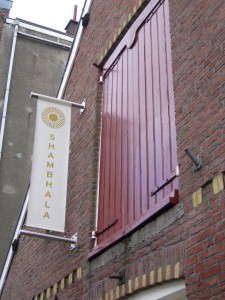
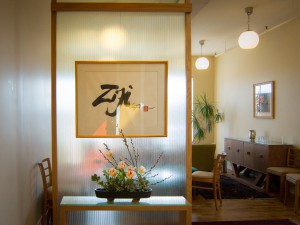
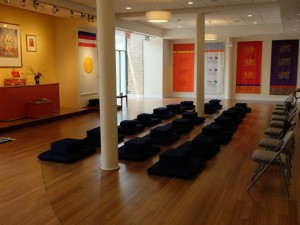
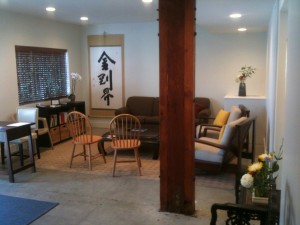
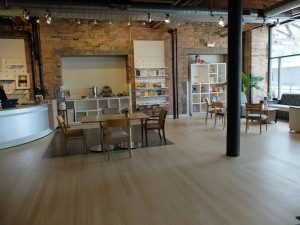




Sep 22, 2014
Reply
oh, maybe the captions were fixed.
I LOVE what is showing as the Toronto photo. Gorgeous!
Sep 22, 2014
Reply
Hi Jacqueline!
The west side L.A photo is indeed a pic of the Westside Shambhala community room in Mar Vista. It’s so great to hear that Toronto has a similarly cheerful and uplifted reno!! I hope to visit one day.
The calligraphy in the corner is an original by Maezumi Roshi, a friend of the Vidyadhara. (The calligraphy is “Vajradhatu” c. 1980’s.) We raised funds for it to be mounted so it could be displayed.
One of my favorite aspects of our new space (actually, 1.5 years) is the kitchen. It opens onto the community room and has an island that has become a perfect place to gather. We set out snacks and stools and it becomes a magnet for sharing, communication and cheer.
Thanks, Guy Blume, for creating the beautiful open planned, harmonious community and meditation center, Westside Shambhala.
Sep 22, 2014
Reply
I notice that food comes first. Not accidental? Congratulations Chicago. I know your space is relatively new. It looks wonderful!
Sep 16, 2014
Reply
hi there,
The photo captioned west side LA is actually the new Toronto community room. I suspect the captions were just crossed. We renovated last year and it feels so cheerful and uplifted!